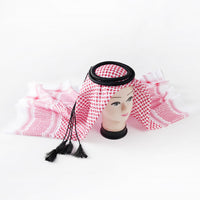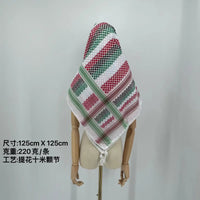Ghutra
Geography: Used mainly in countries such as Saudi Arabia and the UAE.
Design: The Ghutra is usually white in color and also comes in red and white versions. The white Ghutra is a common choice for formal occasions, while the red and white version (also known as Shemagh) is more commonly used for informal occasions.
Material: Lightweight cotton or blended materials are commonly used, which are breathable and suitable for tropical and desert climates.
Wearing Style: The Ghutra is usually placed on the head and held in place by an Agal (a round black headband), which is neatly shaped and traditionally formal.
Keffiyeh

Region: Used mainly in Palestine and other Middle Eastern regions.
Design: The common pattern of the Keffiyeh is a black-and-white or red-and-white checkered pattern with a distinctive local flavor. The patterns are more distinctive and conspicuous, and the Keffiyeh is more varied in pattern and color than the Ghutra.

Material: Typically made of thicker cotton or blended materials, the Keffiyeh is suitable for a wide range of climates, including colder environments.
Wearing Style: The Keffiyeh can be worn in a variety of ways, not only as a headscarf, but also as a scarf, mask, etc. It is usually worn without an Agal, and can be secured in other ways.

Summarize
Appearance: Ghutra is mostly white or red and white, formal and simple; Keffiyeh is mainly black and white or red and white plaid pattern, more decorative.
Wearing style: Ghutra is usually fixed with Agal, which is more formal; Keffiyeh is multifunctional and can be worn in different positions such as on the head, shoulders, etc., which makes the style more casual.

Cultural significance: Both carry rich cultural connotations, but the Ghutra is more common in Saudi Arabia and the UAE, while the Keffiyeh is more associated with Palestinian culture.
The two types of scarves differ not only in function, but also in culture and fashion.





